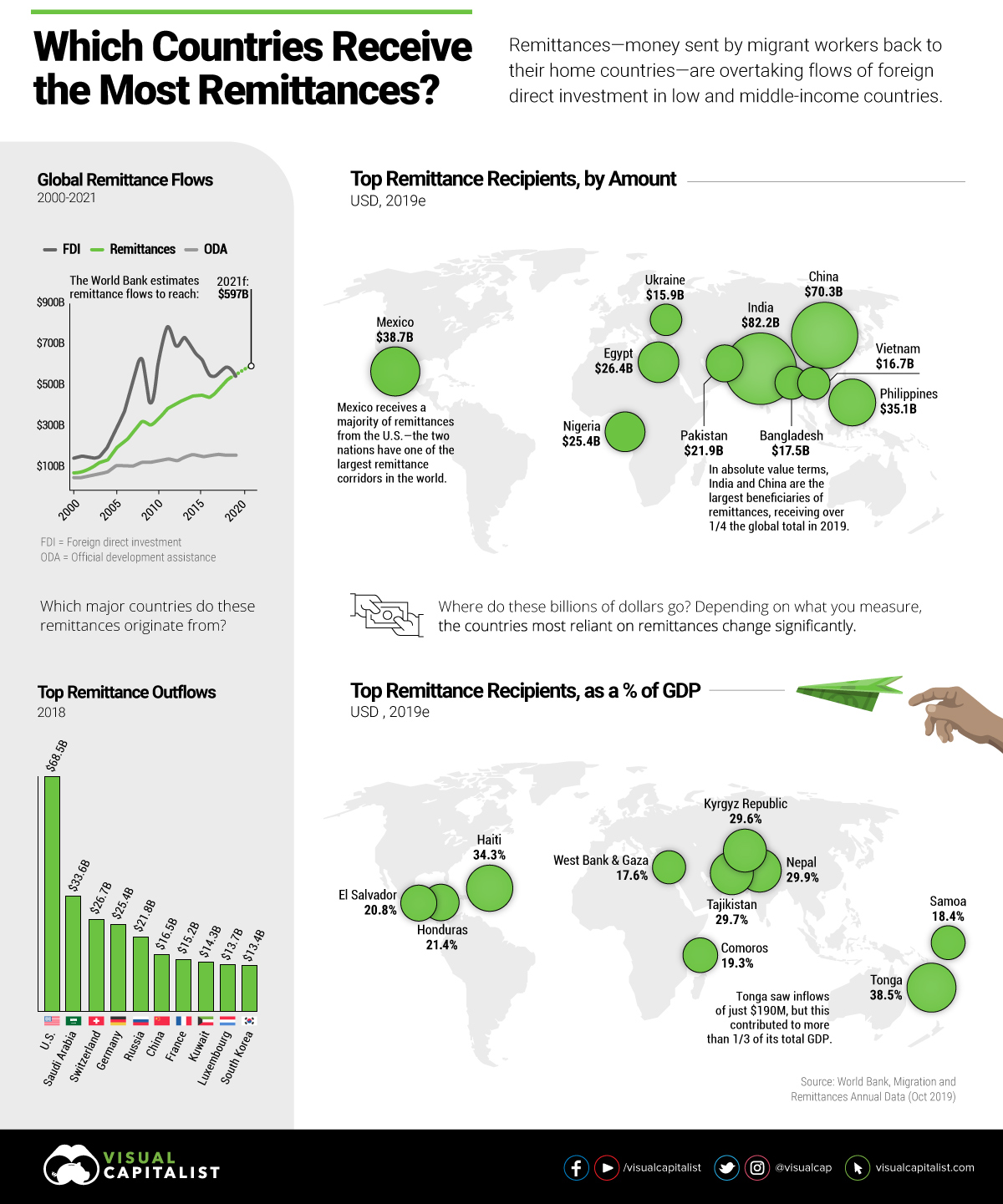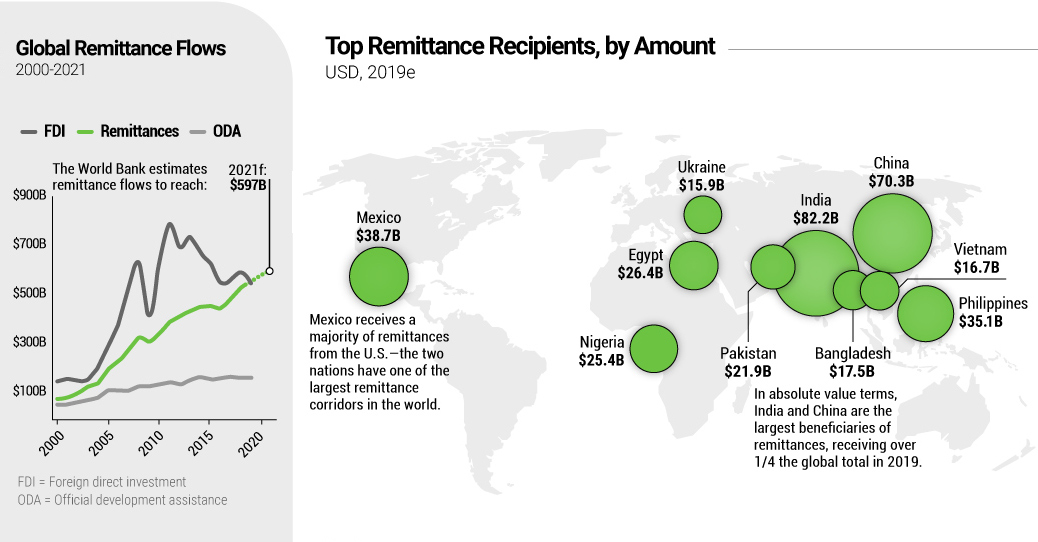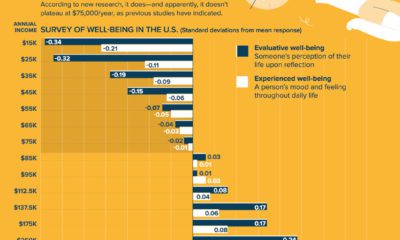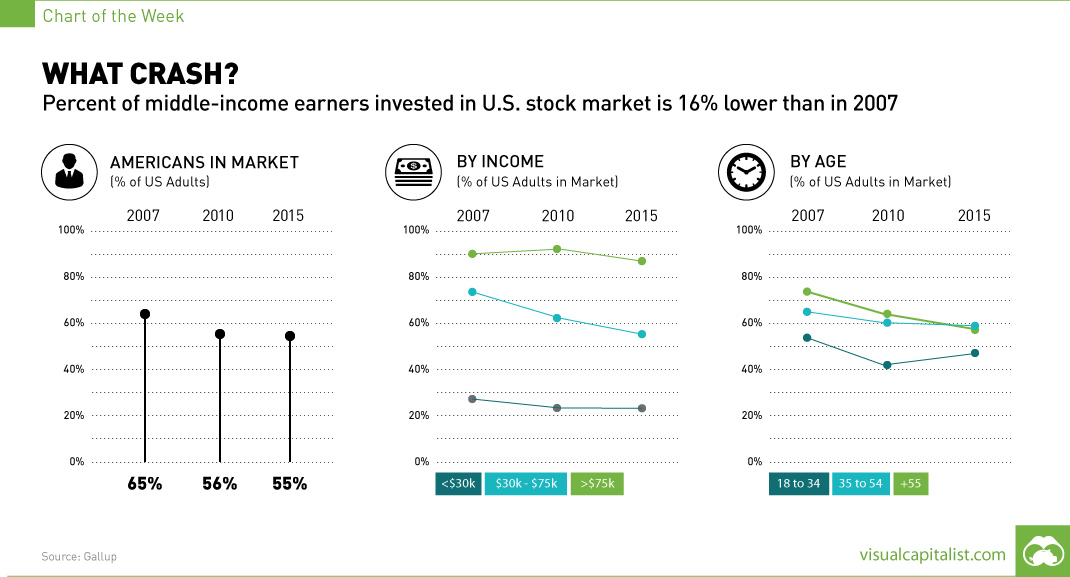Money
Mapped: The Ins and Outs of Remittance Flows

Mapped: The Ins and Outs of Remittance Flows
The global immigrant population is growing at a robust pace, and their aggregate force is one to be reckoned with. In 2019, migrants collectively sent $550.5 billion in money back to their home countries—money transfer flows that are also known as remittances.
Remittances serve as an economic lifeline around the world, particularly for low- and middle-income countries (LMICs). Today’s visualization relies on the latest data from the World Bank to create a snapshot of these global remittance flows.
Where do most of these remittances come from, and which countries are the biggest recipients?
Remittances: An Origin Story
Remittances are a type of capital flow, with significant impacts on the places they wind up. These money transfers have surpassed official aid being sent to LMICs for decades, and in this day and age, are rivaling even Foreign Direct Investment (FDI) flows.
Remittance flows mainly help improve basic living standards such as housing, healthcare, and education, with leftover funds going towards other parts of the economy. They can also be a means for increasing the social mobility of family and friends back home.
Altogether, 50% of remittances are sent in either U.S. dollars, or the closely-linked currencies of Gulf Cooperation Council (GCC) countries, such as the Saudi riyal. It’s not surprising then, that the U.S. is the biggest origin country of remittances, contributing $68.5 billion in 2018—more than double that of the next-highest country, Saudi Arabia, at $33.6 billion.
Remittance Flows As A Safety Net
The impact of remittances on LMICs can vary depending on what you measure. In absolute terms, the top 10 LMIC recipients received $350 billion, or nearly 64% of total remittances in 2019.
Top Remittance Recipients in 2019 (USD)
| Rank | Country | Remittance Inflows | % of Nominal GDP |
|---|---|---|---|
| #1 | 🇮🇳 India | $82.2B | 2.8% |
| #2 | 🇨🇳 China | $70.3B | 0.5% |
| #3 | 🇲🇽 Mexico | $38.7B | 3.1% |
| #4 | 🇵🇭 Philippines | $35.1B | 9.8% |
| #5 | 🇪🇬 Egypt | $26.4B | 8.8% |
| #6 | 🇳🇬 Nigeria | $25.4B | 5.7% |
| #7 | 🇵🇰 Pakistan | $21.9B | 7.9% |
| #8 | 🇧🇩 Bangladesh | $17.5B | 5.5% |
| #9 | 🇻🇳 Vietnam | $16.7B | 6.4% |
| #10 | 🇺🇦 Ukraine | $15.9B | 11.8% |
India tops the chart as the largest remittances beneficiary, followed by China and Mexico. Interestingly, these three countries are also the main destinations of remittance flows from the U.S., but in the reverse order. Mexico and the U.S. have one of the most interconnected remittance corridors in the world.
However, the chart above makes it clear that simply counting the dollars is only one part of the picture. Despite these multi-billion dollar numbers, remittances are equal to only a fraction of these economies.
By looking at remittances as a percentage of nominal GDP, it’s clear that they can have an outsize impact on nations, even if the overall value of flows are much lower in comparison.
Top Remittance Recipients in 2019 (% of GDP)
| Rank | Country | Remittance Inflows | % of Nominal GDP |
|---|---|---|---|
| #1 | 🇹🇴 Tonga | $0.19B | 38.5% |
| #2 | 🇭🇹 Haiti | $3.3B | 34.3% |
| #3 | 🇳🇵 Nepal | $8.6B | 29.9% |
| #4 | 🇹🇯 Tajikistan | $2.3B | 29.7% |
| #5 | 🇰🇬 Kyrgyz Republic | $2.4B | 29.6% |
| #6 | 🇭🇳 Honduras | $5.3B | 21.4% |
| #7 | 🇸🇻 El Salvador | $5.6B | 20.8% |
| #8 | 🇰🇲 Comoros | $0.14B | 19.3% |
| #9 | 🇼🇸 Samoa | $0.17B | 18.4% |
| #10 | 🇵🇸 West Bank and Gaza | $2.6B | 17.6% |
It’s clear that the cash influxes provided by remittances are crucial to many smaller countries. Take the Polynesian archipelago of Tonga, for example: even though it only saw $190 million in remittances from abroad, that amount accounts for nearly 40% of the country’s nominal GDP.
Will The Remittance Tides Turn?
The World Bank projects remittance flows to increase to nearly $600 billion by 2021. But are such projections of future remittance flows reliable? The researchers offer two reasons why remittances may ebb and flow.
On one hand, anti-immigration sentiment across major economies could complicate this growth, as evidenced by Brexit. The good news? That doesn’t stop immigration itself from taking place. Instead, where these migrants and their money end up, are constantly in flux.
This means that as immigration steadily grows, so will remittance flows. What’s more, fintech innovations have the potential to bolster this progress, by making money transfers cheaper and easier to access.
Tackling [high transaction costs] is crucial not only for economic and social development, but also for improving financial inclusion.
—UN ESCAP, Oct 2019
Money
Charted: Which City Has the Most Billionaires in 2024?
Just two countries account for half of the top 20 cities with the most billionaires. And the majority of the other half are found in Asia.

Charted: Which Country Has the Most Billionaires in 2024?
This was originally posted on our Voronoi app. Download the app for free on iOS or Android and discover incredible data-driven charts from a variety of trusted sources.
Some cities seem to attract the rich. Take New York City for example, which has 340,000 high-net-worth residents with investable assets of more than $1 million.
But there’s a vast difference between being a millionaire and a billionaire. So where do the richest of them all live?
Using data from the Hurun Global Rich List 2024, we rank the top 20 cities with the highest number of billionaires in 2024.
A caveat to these rich lists: sources often vary on figures and exact rankings. For example, in last year’s reports, Forbes had New York as the city with the most billionaires, while the Hurun Global Rich List placed Beijing at the top spot.
Ranked: Top 20 Cities with the Most Billionaires in 2024
The Chinese economy’s doldrums over the course of the past year have affected its ultra-wealthy residents in key cities.
Beijing, the city with the most billionaires in 2023, has not only ceded its spot to New York, but has dropped to #4, overtaken by London and Mumbai.
| Rank | City | Billionaires | Rank Change YoY |
|---|---|---|---|
| 1 | 🇺🇸 New York | 119 | +1 |
| 2 | 🇬🇧 London | 97 | +3 |
| 3 | 🇮🇳 Mumbai | 92 | +4 |
| 4 | 🇨🇳 Beijing | 91 | -3 |
| 5 | 🇨🇳 Shanghai | 87 | -2 |
| 6 | 🇨🇳 Shenzhen | 84 | -2 |
| 7 | 🇭🇰 Hong Kong | 65 | -1 |
| 8 | 🇷🇺 Moscow | 59 | No Change |
| 9 | 🇮🇳 New Delhi | 57 | +6 |
| 10 | 🇺🇸 San Francisco | 52 | No Change |
| 11 | 🇹🇭 Bangkok | 49 | +2 |
| 12 | 🇹🇼 Taipei | 45 | +2 |
| 13 | 🇫🇷 Paris | 44 | -2 |
| 14 | 🇨🇳 Hangzhou | 43 | -5 |
| 15 | 🇸🇬 Singapore | 42 | New to Top 20 |
| 16 | 🇨🇳 Guangzhou | 39 | -4 |
| 17T | 🇮🇩 Jakarta | 37 | +1 |
| 17T | 🇧🇷 Sao Paulo | 37 | No Change |
| 19T | 🇺🇸 Los Angeles | 31 | No Change |
| 19T | 🇰🇷 Seoul | 31 | -3 |
In fact all Chinese cities on the top 20 list have lost billionaires between 2023–24. Consequently, they’ve all lost ranking spots as well, with Hangzhou seeing the biggest slide (-5) in the top 20.
Where China lost, all other Asian cities—except Seoul—in the top 20 have gained ranks. Indian cities lead the way, with New Delhi (+6) and Mumbai (+3) having climbed the most.
At a country level, China and the U.S combine to make up half of the cities in the top 20. They are also home to about half of the world’s 3,200 billionaire population.
In other news of note: Hurun officially counts Taylor Swift as a billionaire, estimating her net worth at $1.2 billion.
-

 Mining1 week ago
Mining1 week agoGold vs. S&P 500: Which Has Grown More Over Five Years?
-

 Markets2 weeks ago
Markets2 weeks agoRanked: The Most Valuable Housing Markets in America
-

 Money2 weeks ago
Money2 weeks agoWhich States Have the Highest Minimum Wage in America?
-

 AI2 weeks ago
AI2 weeks agoRanked: Semiconductor Companies by Industry Revenue Share
-

 Markets2 weeks ago
Markets2 weeks agoRanked: The World’s Top Flight Routes, by Revenue
-

 Countries2 weeks ago
Countries2 weeks agoPopulation Projections: The World’s 6 Largest Countries in 2075
-

 Markets2 weeks ago
Markets2 weeks agoThe Top 10 States by Real GDP Growth in 2023
-

 Demographics2 weeks ago
Demographics2 weeks agoThe Smallest Gender Wage Gaps in OECD Countries







